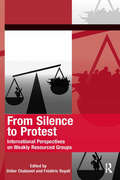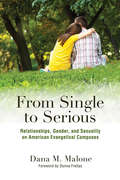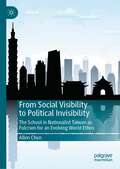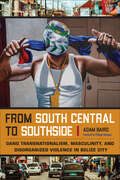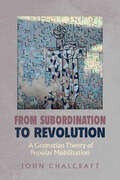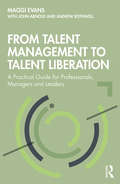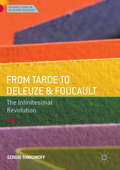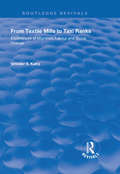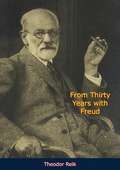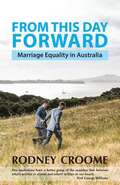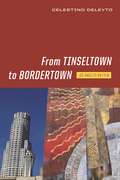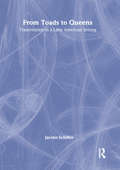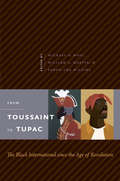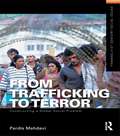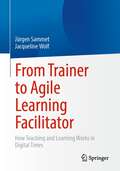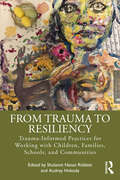- Table View
- List View
From Silence to Protest: International Perspectives on Weakly Resourced Groups (The\mobilization Series On Social Movements, Protest, And Culture Ser.)
by Frédéric Royall Didier ChabanetThe editors of this book examine social movement scholars’ use of contemporary concepts and paradigms in the study of protest as they analyse the extent to which these tools are valid (or not) in very different regional - and thus political or cultural - contexts. The authors posit that ’weakly resourced groups’ are a particularly useful point of departure to evaluate the strengths and weaknesses of three key social movement schools of analysis: resource mobilization, political opportunity structures, and frame analysis. Some of the groups considered in this volume are financially disadvantaged, lacking money and work; others are economically disadvantaged, with members having precarious, part-time, or short-term jobs; some are socially disadvantaged, with fragile networks of solidarity; others are culturally disadvantaged, with members continuously victimized, stigmatized and rejected; finally some are politically disadvantaged when they have little or no access to decision-making structures. These exclusionary factors can be cumulative and give way to different outcomes. The chapters cover a large range of examples including urban riots in France and in Great Britain, the World Social Forums of Dakar and Nairobi, the struggles of precarious workers in Italy and Greece, unemployed mobilization in Germany and Ireland, the mobilization of the Roma and Muslims in Europe, the Brazilian landless movement, the mobilization of small farmers in France, as well as mobilization in authoritarian states such as Morocco and Cuba. This book will be of interest to scholars, students and activists working within social movement studies.
From Single to Serious: Relationships, Gender, and Sexuality on American Evangelical Campuses
by Dana M. MaloneCollege students hook up and have sex. That is what many students expect to happen during their time at university—it is part of growing up and navigating the relationship scene on most American campuses today. But what do you do when you’re a student at an evangelical university? Students at these schools must negotiate a barrage of religiously imbued undercurrents that impact how they think about relationships, in addition to how they experience and evaluate them. As they work to form successful unions, students at evangelical colleges balance sacred ideologies of purity, holiness, and godliness, while also dealing with more mainstream notions of popularity, the online world, and the appeal of sexual intimacy. In From Single to Serious, Dana M. Malone shines a light on friendship, dating, and, sexuality, in both the ideals and the practical experiences of heterosexual students at U. S. evangelical colleges. She examines the struggles they have in balancing their gendered and religious presentations of self, the expectations of their campus community, and their desire to find meaningful romantic relationships.
From Snapshots to Social Media - The Changing Picture of Domestic Photography
by Risto Sarvas David M. FrohlichFrom Snapshots to Social Media describes the history and future of domestic photography as mediated by technological change. Domestic photography refers to the culture of ordinary people capturing, sharing and using photographs, and is in a particular state of flux today as photos go digital. The book argues that this digital era is the third major chapter in the 170 year history of the area; following the portrait and Kodak eras of the past. History shows that despite huge changes in photographic technology and the way it has been sold, people continue to use photographs to improve memory, support communication and reinforce identity. The future will involve a shift in the balance of these core activities and a replacement of the family album with various multimedia archives for individuals, families and communities. This raises a number of issues that should be taken into account when designing new technologies and business services in this area, including: the ownership and privacy of content, multimedia standards, home ICT infrastructure, and younger and older users of images. The book is a must for designers and engineers of imaging technology and social media who want a better understanding of the history of domestic photography in order to shape its future. It will also be of value to students and researchers in science and technology studies and visual culture, as a fascinating case study of the evolving use of photographs and photographic technology in Western society.
From Social Visibility to Political Invisibility: The School in Nationalist Taiwan as Fulcrum for an Evolving World Ethos
by Allen ChunThis book began as a year-long ethnography of a school in Taiwan in 1991 then evolved more into a historical sociology of national formation and its cultural mindset. Cultural nationalism is a widely debated but poorly understood process. Contrary to prevailing perceptions, the Cold War may have given way to a more progressive open society, but the politicization of ethnicity hardened a more deeply entrenched cultural frame of mind. Instead of liberating an indigenous reality, Taiwanese consciousness has ironically polarized the political dead ends of reunification and independence. In the final analysis, the ethnography can serve as a paradigmatic case study for critical cultural studies. There are clear ramifications also for a comparative study of the cultural politics of other Chinese speaking or Asian societies and their histories.
From Society to System: The Social Theory of Michel Freitag
by Michel FreitagFrom Society to System presents sociologist Michel Freitag’s (1935-2009) distinctive, multifaceted and interdisciplinary work. Elaborated within the grand sociological tradition, his dialectical sociology redefines sociality as the realm of the symbolic to pinpoint its ontological frailty. Such a perspective expands the borders within sociology to rejoin classical philosophical preoccupations, revisiting social ontology as a radical critique of contemporary society where not only life and planet earth is at stake as a result of capitalism but reflexivity as well. This collection of essays touches on topics that have been of central concern for social theory since the end of the 20th century: the discussion about holism versus individualism and the dissolution of transcendental identity; the current state of the social sciences, both epistemologically and practically; the end-of-20th century debate over the nature of society along with its future in the context of globalisation. These essays show how Freitag’s sociology is part of a larger unified framework that integrates ontology, epistemology, anthropology and philosophy into a coherent vision of the world – testifying to the distinctiveness of Freitag’s social theory, standing next to other great social theorists such as Margaret Archer, Jürgen Habermas, Murray Bookchin and Ulrich Beck.
From South Central to Southside: Gang Transnationalism, Masculinity, and Disorganized Violence in Belize City (Studies in Transgression)
by Adam BairdWhen he visited in 2011, sociologist Adam Baird wondered what the Bloods and Crips were doing in Southside Belize City. He soon discovered that migrant Belizean members of colors gangs from South Central Los Angeles were deported there in the 1980s. Once established “back home,” membership in the Bloods and Crips was seen as an aspirational pathway to manhood for the urban underclass. From South Central to Southside charts the genesis and evolution of a transnational gang culture. Baird provides firsthand interviews with gang members and “narco” families and explains the surprising source of Belize City’s severe violence and skyrocketing homicide rates. He identifies gang violence in the U.S. and Belize as stemming from populations blighted by historical, brutal inequality and marginalization. Analyzing the gendered dynamics as young men and women face the temptations, risks, and dangers of gang life, Baird shines a light on “chronic vulnerability" in Belize City.
From Startup to Exit: An Insider's Guide to Launching and Scaling Your Tech Business
by Shirish NadkarniTech entrepreneurs, make your startup dreams come true by utilizing this invaluable, founder-to-founder guide to successfully navigating all phases of the tech startup journey.With the advent of the internet, mobile computing, and now AI/Machine learning and cloud computing, the number of new startups has accelerated over the last decade across tech centers in Silicon Valley, Israel, India, and China. From Startup to Exit shares the knowledge that pioneering, serial entrepreneur Shirish Nadkarni has gained from over two decades of success, detailing the practical aspects of startup formation from founding, funding, management, and finding an exit. With successful tech entrepreneurs interviewed and featured throughout, From Startup to Exit will help you:Understand exactly what tech startups must do to succeed in all phases, from idea stage to IPO.Gain invaluable insights from the journeys of other successful tech founders that can be applied to your own situation.Learn how to raise millions of dollars of funding from angels and VCs to give your company the fuel it needs to take off and succeed.
From Steel to Slots: Casino Capitalism in the Postindustrial City
by Chloe E. TaftBethlehem PA was synonymous with steel. But after the factories closed, the city bet its future on casino gambling. Chloe Taft describes a city struggling to make sense of the ways global capitalism transforms jobs, landscapes, and identities. While residents often have few cards to play, the shape economic progress takes is not inevitable.
From Stone Orchard: A Collection of Memories
by Timothy FindleyThis collection illustrates some of Findley's popular columns from Harrowsmith Magazine and a few new reflections on his feelings about Stone Orchard and his imminent departure from it.
From Stress to Wellbeing Volume 2
by Cary L. CooperA comprehensive collection by Professor Cary Cooper and his colleagues in the field of workplace stress and wellbeing, which draws on research in a number of areas including stress-strain relationships, sources of workplace stress and stressful occupations. Volume 2 of 2.
From Subordination to Revolution: A Gramscian Theory of Popular Mobilization
by John ChalcraftAt a time of mass discontent, revolutionary weakness, and right-wing ascendancy, John Chalcraft presents a new theory of popular mobilization. From Subordination to Revolution is based on an innovative reading of the living Gramscian tradition, and it offers an alternative to conservative, liberal, Marxist, and poststructuralist theory. Drawing on examples from across the globe, Chalcraft defines popular mobilization as the many ways in which subordinated groups rearrange their relationships to challenge and overcome domination. The theory sets out a fertile constellation of concepts encompassing the many faces and phases of the long journey from subordination to revolution. This approach breaks ground in connecting the social, structural, spatio-temporal, strategic, and transnational elements of popular mobilization. It also enables Chalcraft to situate anew the fundamental issues of domination, autonomy, consent, and leadership and put forward new arguments about party and bloc. The point is to link together diverse popular struggles in the contemporary world.
From Suburb to Shtetl: The Jews of Boro Park
by William B. Helmreich Egon Mayer"From Suburb to Shtetl" is an outstanding ethnography that moves beyond simple demographics. Mayer weaves an intricate tapestry of how family, school, and community leaders influence each other. Whether discussing the role of the rebbe or the matchmaker, those who know these communities will find what he says as relevant today as it was when first penned. This is hardly surprising, for the ultra-Orthodox community takes great pride in not changing, in maintaining itself as it was in Europe despite the allure of modern American society. His discussion of synagogue life is particularly informative and evocative. Those in charge of helping immigrants adopted the path of least resistance, allowing and even encouraging them to retain their identities except for those few aspects that might threaten the country's national interests. The American Orthodox community was tremendously augmented by the arrival from Europe, after World War Two, of thousands of Orthodox Jews who remained devoted to that way of life. Egon Mayer was himself part of a smaller, but significant group of Jews who came to the U.S. and settled mostly in Boro Park in the wake of the 1956 Hungarian Revolution. The interaction between the Hasidim and their less fervent Orthodox counterparts described and analyzed in this volume tells us a great deal about how people negotiate their beliefs, values, and norms when forced into close contact with each other in an urban setting within the larger American culture. By exploring these and many other related issues Mayer has given us the chance to assess and forecast the future of American Jewish life as a whole.
From Talent Management to Talent Liberation: A Practical Guide for Professionals, Managers and Leaders
by John Arnold Andrew Rothwell Maggi EvansAs the pace of change increases and new business structures evolve, finding and harnessing people’s talent is becoming ever more important. From Talent Management to Talent Liberation presents a thoughtful and practical approach to talent. It provides compelling evidence for the limitations of talent management practice and offers talent liberation as an alternative approach. Talent Liberation is positioned through five premises that draw on the agile movement to provide a fundamental reappraisal of the talent agenda. These premises are then applied through a range of strategic and tactical tools such as the Talent Compass. By combining academic research, thought leadership and practical experience, this book will stimulate fresh thinking. Readers will be inspired to take action, using the simple tools to liberate more of the talent in their organisation and their teams. Leaders, HR professionals and individuals will benefit from the relevant insights shared here.
From Tarde to Deleuze and Foucault: The Infinitesimal Revolution (Palgrave Studies in Relational Sociology)
by Sergio TonkonoffThis book posits that a singular paradigm in social theory can be discovered by reconstructing the conceptual grammar of Gabriel Tarde's micro-sociology and by understanding the ways in which Gilles Deleuze's micro-politics and Michel Foucault's micro-physics have engaged with it. This is articulated in the infinite social multiplicity-invention-imitation-opposition-open system. Guided by infinitist ontology and an epistemology of infinitesimal difference, this paradigm offers a micro-socio-logic capable of producing new ways of understanding social life and its vicissitudes. In the field of social theory, this can be called the infinitesimal revolution.
From Tenements to the Taylor Homes: In Search of an Urban Housing Policy in Twentieth-Century America (G - Reference, Information and Interdisciplinary Subjects)
by John F. Bauman Roger Biles Kristin M. SzylvianAuthored by prominent scholars, the twelve essays in this volume use the historical perspective to explore American urban housing policy as it unfolded from the late nineteenth through the twentieth centuries. Focusing on the enduring quest of policy makers to restore urban community, the essays examine such topics as the war against the slums, planned suburbs for workers, the rise of government-aided and built housing during the Great Depression, the impact of post–World War II renewal policies, and the retreat from public housing in the Nixon, Carter, and Reagan years.
From Textile Mills to Taxi Ranks: Experiences of Migration, Labour and Social Change (Routledge Revivals)
by Virinda S KalraThis title was first published in 2000: Contemporary academic studies on economic activity and South Asians in Britain have tended to concentrate on self-employment and entrepreneurial business success, and it may be possible to forget that many South Asians came to Britain to work in declining manufacturing industries. The phrase "from textile mills to taxi ranks" is not only a metonym for the movement to a service sector economy, but also presents a shift in place of work for many (Azad) Kahmiri/Pakistani men. The author explores the way in which issues of employment, work, income generation and economic status affect, and are affected by, a section of the Mirpuri/Pakistani "community" based in Oldham. The men discussed have strong emotional, spiritual and material ties to the geographical district of Mirpur and stories of workers and industry, home and aborad, dreams and realities, merge and entwine with the practices of everyday life.
From Thirty Years with Freud
by Theodor ReikOriginally published in 1940, From Thirty Years with Freud by Theodor Reik is the English translation of a collection of essays presenting the author’s memories of Freud. The book includes an unknown lecture of Freud, Freud as a critic of our culture, and diverse subjects treated from the psychoanalytic standpoint. Several of these articles have appeared elsewhere before, mostly in German. The final group of essays, originally dedicated to Freud on his successive birthdays, deal with embarrassment in greeting, the latent meaning of elliptical distortion, and the nature of Jewish wit.“In this series of letters, essays, and comments, Reik endeavors to convey something of his own intimate veneration of Freud to the lay reader. The book…breathes sincerity, honesty, and scientific curiosity.”—Karl Menninger
From This Day Forward: Marriage Equality in Australia
by Rodney CroomeAustralia is now the only developed English-speaking country where same-sex couples can't marry. In this timely book, one of Australia's leading marriage equality advocates goes beyond the slogans and sound bites to explain why the nation is debating marriage equality, why the reform matters and how reform can be achieved. Along the way he considers the history of freedom to marry in Australia, what debate on marriage equality reveals about his home state of Tasmania, and how gay identity and marriage have evolved to the point where marriage equality is not only possible but likely.
From Tinseltown to Bordertown: Los Angeles on Film (Contemporary Approaches to Film and Media Series)
by Celestino DeleytoLos Angeles is a global metropolis whose history and social narrative is linked to one of its top exports: cinema. L.A. appears on screen more than almost any city since Hollywood and is home to the American film industry. Historically, conversations of social and racial homogeneity have dominated the construction of Los Angeles as a cosmopolitan city, with Hollywood films largely contributing to this image. At the same time, the city is also known for its steady immigration, social inequalities, and exclusionary urban practices, not dissimilar to any other borderland in the world. The Spanish names and sounds within the city are paradoxical in relation to the striking invisibility of its Hispanic residents at many economic, social, and political levels, given their vast numbers. Additionally, the impact of the 1992 Los Angeles riots left the city raw, yet brought about changing discourses and provided Hollywood with the opportunity to rebrand its hometown by projecting to the world a new image in which social uniformity is challenged by diversity. It is for this reason that author Celestino Deleyto decided to take a closer look at how the quintessential cinematic city contributes to the ongoing creation of its own representation on the screen. From Tinseltown to Bordertown: Los Angeles on Film starts from the theoretical premise that place matters. Deleyto sees film as predominantly a spatial system and argues that the space of film and the space of reality are closely intertwined in complex ways and that we should acknowledge the potential of cinema to intervene in the historical process of the construction of urban space, as well as its ability to record place. The author asks to what extent this is also the city that is being constructed by contemporary movies. From Tinseltown to Bordertown offers a unique combination of urban, cultural, and border theory, as well as the author’s direct observation and experience of the city’s social and human geography with close readings of a selection of films such as Falling Down, White Men Can’t Jump, and Collateral. Through these textual analyses, Deleyto tries to situate filmic narratives of Los Angeles within the city itself and find a sense of the “real place” in their fictional fabrications. While in a certain sense, Los Angeles movies continue to exist within the rather exclusive boundaries of Tinseltown, the special borderliness of the city is becoming more and more evident in cinematic stories. Deleyto’s monograph is a fascinating case study on one of the United States’ most enigmatic cities. Film scholars with an interest in history and place will appreciate this book.
From Toads to Queens: Transvestism in a Latin American Setting
by Jacobo SchifterThe information in From Toads to Queens: Transvestism in a Latin American Setting (a 2000 Lammy Nominee) is crucial to understanding Latin American culture and its relation to HIV prevention. You’ll find research findings that offer insights into and analysis of the sexual culture and risk factors that place transvestites in the sex trade and their customers at risk of contracting HIV. This information could prove valuable to developing preventions and interventions for similar populations in countries all over the world.In From Toads to Queens, transvestites in the sex trade and their customers share fascinating personal accounts from their daily lives, including details of their sexual encounters. Specifically you will gain insight into: sexual practices pay rates in the sex trade types of lovers and sexual partners locations of “work” conceptions of fashion and beauty among transvestites relations between transvestites, the police, and gay bashers clients who are heterosexual men drug consumption and unsafe sexFrom this book, you will gain a comprehensive analysis of Latin transvestites, how this population questions assumptions about sexual orientation and practice, and how they are affected by the HIV/AIDS epidemic. Most importantly, From Toads to Queens documents boundry-crossing individuals’existence and subverts the simplistic division of people into traditional psychiatric categories, a crucial first step in devising ways to decrease the rates of HIV infection among specific populations.
From Toussaint To Tupac
by Michael O. West William G. Martin Fanon Che WilkinsTranscending geographic and cultural lines,From Toussaint to Tupacis an ambitious collection of essays exploring black internationalism and its implications for a black consciousness. At its core, black internationalism is a struggle against oppression, whether manifested in slavery, colonialism, or racism. The ten essays in this volume offer a comprehensive overview of the global movements that define black internationalism, from its origins in the colonial period to the present. From Toussaint to Tupacfocuses on three moments in global black history: the American and Haitian revolutions, the Garvey movement and the Communist International following World War I, and the Black Power movement of the late twentieth century. Contributors demonstrate how black internationalism emerged and influenced events in particular localities, how participants in the various struggles communicated across natural and man-made boundaries, and how the black international aided resistance on the local level, creating a collective consciousness. In sharp contrast to studies that confine Black Power to particular national locales, this volume demonstrates the global reach and resonance of the movement. The volume concludes with a discussion of hip hop, including its cultural and ideological antecedents in Black Power. Contributors: Hakim Adi, Middlesex University, London Sylvia R. Frey, Tulane University William G. Martin, Binghamton University Brian Meeks, University of the West Indies, Mona, Jamaica Marc D. Perry, University of Illinois, Urbana-Champaign Lara Putnam, University of Pittsburgh Vijay Prashad, Trinity College Robyn Spencer, Lehman College Robert T. Vinson, College of William and Mary Michael O. West, Binghamton University Fanon Che Wilkins, Doshisha University, Kyoto, Japan
From Trafficking to Terror: Constructing a Global Social Problem (Framing 21st Century Social Issues)
by Pardis MahdaviA panic surrounds human trafficking and terrorism. The socially constructed 'war on terror’ and ‘war on trafficking’?are linked through discourses that not only combine the two, but help promote an anti-Muslim sentiment. Using ethnographic data and stories, From Trafficking to Terror presents the need to challenge the trafficking and terror paradigm, and rethink approaches to the large scale challenges these discourses have created. This book is ideal for courses on gender, labor, migration, human rights and globalization.
From Trainer to Agile Learning Facilitator: How Teaching and Learning Works in Digital Times
by Jacqueline Wolf Jürgen SammetPure face-to-face training is increasingly being supplemented or even replaced by modern forms of learning such as blended learning, online training, e-learning and informal learning. What does this mean for you as a trainer (lecturer, speaker, personnel developer)?This reference book shows how the job description of the trainer is changing due to digitalisation and which competences you need as a trainer to be successful in the "learning revolution". After all, specialist knowledge paired with classroom didactics is no longer enough.This work takes you by the hand to become a learner again as a trainer and to develop into an "agile learning facilitator". It gives you orientation in the digital "trainer competence jungle". In a practical and clearly understandable way, you will receive both theoretical background knowledge and practical implementation possibilities for the modernisation of your continuing education programme.
From Traitor to Zealot: Exploring the Phenomenon of Side-Switching in Extremism and Terrorism
by Daniel KoehlerWhat makes a neo-Nazi become a convinced anti-fascist or a radical left-winger become a devout Salafist? How do they manage to fit into their new environment and gain acceptance as a former enemy? The people featured in this book made highly puzzling journeys, first venturing into extremist milieus and then deciding to switch to the opposite side. By using their extraordinary life-stories and their own narratives, this book provides the first in-depth analysis of how and why people move between seemingly opposing extremist environments that can sometimes overlap and influence each other. It aims to understand how these extremists manage to convince their new group that they can be trusted, which also allows us to dive deep into the psychology of extremism and terrorism. This fascinating work will be of immense value to those studying radicalization and counter-radicalization in terrorism studies, social psychology and political science.
From Trauma to Resiliency: Trauma-Informed Practices for Working with Children, Families, Schools, and Communities
by Shulamit Natan Ritblatt and Audrey HokodaFrom Trauma to Resiliency integrates research and practice of trauma-informed care, reviewing the neuroscience of trauma and highlighting relationship-based interventions for diverse populations that have faced multiple traumas. Chapters explore the experiences of oppressed groups that include survivors of abuse, war, poverty, Indigenous youth, Middle Eastern refugee mothers, individuals who identify as sexual and/or gender minorities (SGM), and children and youth involved in child welfare, foster care, and juvenile justice systems. In each chapter, contributors provide strengths-based, trauma-informed strategies that can be used in clinical settings, school-based programs, and in urban communities where food insecurity, limited access to health services, and community violence are prevalent. Professionals and students in counseling, social work, psychology, child welfare, education, and other programs will come away from the book with culturally affirming, trauma-informed interventions and models of care that promote well-being and resilience.
